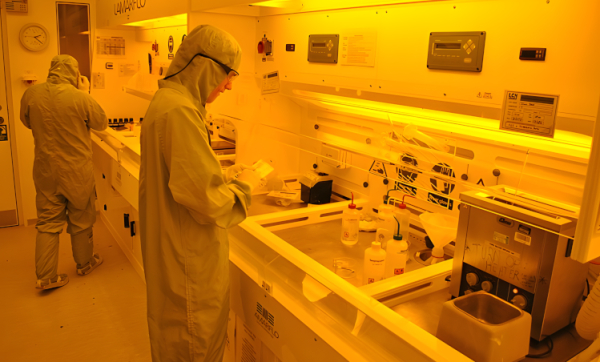Grade 2 stands out due to its widespread application and rigorous standards among the various degrees of vacuum cleanliness. This grade, like others, is determined based on predefined specifications, which provide a benchmark for cleanliness and contamination control. However, what sets Grade 2 apart is its balance between stringent cleanliness requirements and practical applicability in various contexts.
This blog post aims to delve into an in-depth analysis of Grade 2 vacuum cleanliness. We will explore its defining standards, the methods employed to achieve and maintain this level of cleanliness, and the implications of these standards on both process efficiency and product quality. Through this exploration, we seek to underscore the importance of understanding and effectively implementing Grade 2 vacuum cleanliness in relevant industrial settings.
II. Understanding Vacuum Cleanliness
As the term suggests, Vacuum cleanliness pertains to a vacuum environment's purity or contamination-free state. This concept does not merely denote the absence of visible dirt or debris. Still, it extends to microscopic levels, encompassing particles that may be invisible to the naked eye yet significantly impact the operation and performance of vacuum systems. These particles can stem from various sources, including the materials used in manufacturing, the air, human operators, and even the vacuum system itself.
In manufacturing and other industrial applications, vacuum cleanliness is critical. A contaminated vacuum environment can lead to myriad issues, ranging from product defects and system failures to increased maintenance requirements and reduced operational efficiency. These issues, in turn, can result in substantial financial losses and potential reputational damage for organizations. Therefore, maintaining vacuum cleanliness is not just a matter of adhering to standards but a strategic imperative that drives operational excellence and competitive advantage.
The evaluation of vacuum cleanliness is a meticulous process. It involves collecting samples from the vacuum environment, followed by rigorous analysis to identify and quantify the presence of various contaminants. Techniques such as particle counting, microscopic analysis, and spectroscopic methods are commonly employed. The results of these analyses are then compared against predefined cleanliness standards to determine the cleanliness grade of the vacuum environment.
Understanding the measure of vacuum cleanliness requires grasping the concept of cleanliness grades. These grades provide a scale to gauge the cleanliness of a vacuum environment, with each grade representing a specific level of contamination or purity. The grades are determined based on various factors, including the size, type, and quantity of particles present and any potential impact on product performance and system functionality.
Among these cleanliness grades, Grade 2 stands as a key benchmark. Known for its stringent yet applicable standards, Grade 2 vacuum cleanliness is widely used in many industrial applications. The rest of this blog post will explore this grade in-depth, shedding light on its specifications, the methods used to achieve and maintain it, and its implications on manufacturing processes and product quality. As we explore Grade 2 vacuum cleanliness, understanding and maintaining this purity level in vacuum environments will become increasingly evident.
III. An Overview of Cleanliness Grades
Cleanliness grades serves as a standardized framework for quantifying and categorizing the purity of vacuum environments. They provide a comparative measure that allows organizations to evaluate the level of contamination in a vacuum system, align their cleanliness strategies with defined standards, and ensure their manufacturing processes are conducive to high-quality product outcomes.
Each cleanliness grade represents a specific level of contamination, determined based on a comprehensive analysis of various factors. These factors include the size, type, and quantity of contaminant particles in the vacuum environment. More than just a numerical value, these grades also consider the potential impact of the contaminants on the performance, efficiency, and longevity of the vacuum system and the products manufactured within it.
The grading system is designed to cater to the diverse needs of different industrial applications. Some processes might require exceptionally high cleanliness levels due to the products' sensitivity or the precision required in the manufacturing process. For instance, even the smallest contaminants in semiconductor manufacturing can cause defects in the fabricated microstructures, necessitating a high cleanliness grade.
Conversely, other applications may have more lenient cleanliness requirements, allowing for more permissible contamination. Organizations must understand the specific cleanliness grade required for their application and implement strategies that consistently meet or exceed these standards.
In this spectrum of cleanliness grades, Grade 2 occupies a significant position. It balances stringent cleanliness requirements and widespread applicability across various industries. Its standards are robust enough to ensure high-quality outcomes in sensitive manufacturing processes yet practical enough to be achievable and maintainable in various contexts. The following sections will delve deeper into the specifics of Grade 2 vacuum cleanliness, providing a comprehensive understanding of its standards, implications, and importance in the industrial sector.
IV. Deep Dive into Grade 2 Vacuum Cleanliness
Grade 2 vacuum cleanliness represents a stringent yet broadly applicable standard within vacuum environments. Its robust specifications serve as a benchmark for industries that employ vacuum systems in their manufacturing processes. To fully comprehend the implications and significance of this grade, we must dissect its specifications and delve into how it is achieved and maintained.
The specifications of Grade 2 vacuum cleanliness encompass various criteria. These include the acceptable types, sizes, and quantities of particles, the level of permissible molecular contamination, and other factors related to potential impacts on system performance and product quality. Typically, these specifications are outlined in technical standards or regulatory guidelines, providing organizations with a clear roadmap for achieving and maintaining Grade 2 vacuum cleanliness.
Achieving Grade 2 vacuum cleanliness necessitates a comprehensive strategy encompassing all stages of the manufacturing process. This strategy begins with selecting materials, with preference given to those with low outgassing rates and minimal particle generation. The manufacturing process itself should also be designed to minimize contamination. This might involve the use of cleanrooms or other controlled environments, as well as the implementation of rigorous cleanliness protocols for operators and equipment.
Maintaining Grade 2 vacuum cleanliness is equally important. Regular cleaning and maintenance of the vacuum system are vital to prevent the accumulation of contaminants. Moreover, continuous monitoring and testing are required to ensure ongoing compliance with Grade 2 standards. These tests typically involve particle counting, microscopic analysis, and spectroscopic techniques, which provide quantitative data on the level of contamination in the vacuum environment.
The factors influencing Grade 2 vacuum cleanliness are numerous and varied. They can range from the type of vacuum pump used and the cleanliness of the input gasesto the handling and storage of components and the overall design of the vacuum system. Understanding these factors and how they interact is crucial for organizations aiming to achieve and maintain Grade 2 vacuum cleanliness.
In the ensuing sections, we will explore the practical implications of Grade 2 vacuum cleanliness, discuss its role in various real-world applications, and delve into the challenges and solutions associated with maintaining this cleanliness grade. Through this exploration, the centrality of Grade 2 vacuum cleanliness to efficient, high-quality manufacturing processes will be further underscored.
V. Grade 2 Vacuum Cleanliness in Practice
In practical terms, the implementation of Grade 2 vacuum cleanliness spans a multitude of industries and applications, each presenting its unique set of challenges and considerations. Two industries that prominently feature the use of Grade 2 vacuum cleanliness are semiconductor manufacturing and space technology.
In semiconductor manufacturing, the production of integrated circuits necessitates a highly controlled environment, free from contaminants that could interfere with the delicate manufacturing processes. Here, Grade 2 vacuum cleanliness plays a pivotal role. It ensures that the vacuum chambers where the circuits are produced meet a high standard of cleanliness, thereby reducing the risk of defects and failures in the final products. Achieving and maintaining this level of cleanliness involves rigorous control of the manufacturing environment, meticulous handling and storage of materials, and regular monitoring and cleaning of the vacuum system.
In space technology, the vacuum systems used in the production and testing of spacecraft components and systems must adhere to high cleanliness standards due to the sensitivity of these components and the extreme conditions they will encounter in space. Here too, Grade 2 vacuum cleanliness is crucial. It ensures that these systems function optimally, both during testing on Earth and when deployed in space. Ensuring this level of cleanliness involves similar strategies as in semiconductor manufacturing, but with additional considerations related to the specific requirements of space technology.
In both examples, achieving Grade 2 vacuum cleanliness is no trivial task. It demands a deep understanding of the factors influencing vacuum cleanliness, a comprehensive strategy for controlling them, and a commitment to continuous monitoring and improvement. The following section will explore the wider implications of Grade 2 vacuum cleanliness, underscoring its impact on product performance, system efficiency, and overall operational excellence.
VI. Implications of Grade 2 Vacuum Cleanliness
The attainment and maintenance of Grade 2 vacuum cleanliness bear significant implications for both manufacturing processes' efficiency and the resulting products' quality. By ensuring a high level of cleanliness in the vacuum environment, organizations can mitigate risks associated with contamination, enhance product reliability, and improve overall operational performance.
From a product perspective, adherence to Grade 2 vacuum cleanliness standards can drastically reduce the incidence of defects, thus enhancing product quality and reliability. This reliability is paramount in industries like semiconductor manufacturing or space technology, where products have to function in highly demanding environments. Furthermore, high product quality can lead to increased customer satisfaction and a strengthened market position.
From a process perspective, Grade 2 vacuum cleanliness can enhance the efficiency and longevity of vacuum systems. By minimizing contamination, the wear and tear on system components can be reduced, leading to less downtime for maintenance and repairs. Furthermore, efficient systems can lead to cost savings in energy usage and maintenance expenses.
In conclusion, the implications of Grade 2 vacuum cleanliness extend far beyond the vacuum environment. Its influence permeates the entire operational process, underscoring its criticality in driving product quality, operational efficiency, and overall business success.
VII. The Future of Vacuum Cleanliness
As industries evolve and manufacturing processes become increasingly complex, the standards of vacuum cleanliness, including Grade 2, will likely advance in tandem. Materials science and engineering developments could lead to new methods for achieving and maintaining cleanliness, while improvements in analytical techniques could provide more precise measurements of contamination. Furthermore, digital technologies could enhance the monitoring and control of vacuum environments, enabling more efficient and proactive cleanliness management. As we move into this future, understanding and adhering to the standards of vacuum cleanliness will remain a cornerstone of manufacturing excellence and product quality.
VIII. Conclusion
In essence, Grade 2 vacuum cleanliness represents a critical benchmark in the realm of manufacturing and industrial applications. It plays a pivotal role in enhancing product quality, system efficiency, and overall operational performance by ensuring a balance between stringent cleanliness requirements and practical applicability. As we look towards the future, the importance of understanding and implementing Grade 2 vacuum cleanliness will only continue to grow. Organizations that master this aspect of their operations will be well-positioned to navigate the evolving industrial landscape, and uphold high standards of product reliability and sustainable business success.





